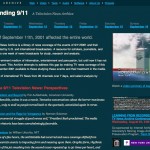
For many in New York and Washington, D.C., Sept. 11, 2001, was a personal experience, an attack on their cities. Most everywhere else in the world, it was a television event.
TV’s commemoration as the 10th anniversary of the event approaches puts that day in many different contexts. There is one place, however, for people to see the Sept. 11 attacks and the week after as they unfolded, without any filters.
The Internet Archive, a California-based organization that collects audio, moving images, and web pages for historical purposes, has put together a television news archive of that day’s coverage.
More than 20 channels were recorded, with more than 3,000 hours of television. Besides major U.S. networks like ABC, CBS, CNN, and NBC, the Internet Archive has posted online TV recordings from Moscow, Paris, London, Baghdad, Tokyo, Ottawa, and elsewhere.
Called “Understanding 9/11,” the site is available at http://www.archive.org/details/911/day.
The material is valuable to researchers and educators, but the Internet Archive wanted to make it easy to use so the general public can go back and see what that day was like, said Brewster Kahle, the organization’s director.
“It is one of the top four or five events that have happened on television,” Kahle said. “You can think of putting a man on the moon, the Watergate hearings, the Kennedy assassination. I’m hopeful that people will come to this and make their own decisions about how they want to think about it, as opposed to politicians who have been pushing and pulling the event for years.”
The archive begins at 8 a.m. ET, or 46 minutes before American Airlines Flight 11 crashed into the North Tower of the World Trade Center.
That alone is interesting for the striking contrast it provides with the last seemingly carefree moments before several tough years.
On NBC’s “Today” show, Katie Couric talks brightly of “a beautiful fall morning in Manhattan,” and the camera pans to a cheering crowd. Charles Gibson mocks his “Good Morning America” colleague Diane Sawyer for writing notes on her hand, and ABC’s Claire Shipman said the biggest news in Washington was Michael Jordan giving hints he might return to the basketball court.
Out of a commercial late in the morning shows, even cutting one commercial short on CNN, suddenly came camera shots of a burning World Trade Center, ones that would dominate screens for several hours.
Newscasters were careful before the story became clear. Matt Lauer initially called it an “accident.” Morning shows effectively used phone calls from eyewitnesses adding details beyond the faraway camera shots. “It’s mind-boggling and it’s horrifying,” one witness, Jennifer Oberstein, told Lauer.
Then came one of many unthinkable moments: a second plane darting into pictures and crashing into the second tower, exploding in a fireball and falling debris.
“We just saw another plane coming in to the other side,” Gibson said. “This looks like there is some sort of concerted effort to attack the World Trade Center that is underway.”
Later, when the towers collapsed, one after the other, it seemed so inconceivable that anchors initially couldn’t grasp what viewers had seen on the screen. NBC’s Tom Brokaw talked of structural damage so severe that the buildings would probably have to be brought down—after one of them already came down on its own.
“The whole side has collapsed,” ABC’s Peter Jennings said when the first tower came down.
“The whole building has collapsed,” ABC’s reporter on the scene, Don Dahler, corrected him.
“The whole building has collapsed?” Jennings responded.
CNN’s Aaron Brown responded with the horror most viewers no doubt felt when the second tower fell. “Good lord,” he said. “There are no words.”
“The landscape of New York has just been changed, and you have to presume that thousands of lives have been extinguished,” Jennings said.
In those early hours, ABC’s John Miller and NBC’s Andrea Mitchell had raised the name of Osama bin Laden as possibly the man behind the attacks, even as the networks reported the false claim of a Palestinian organization taking credit.
Also interesting are the perspectives from overseas. The BBC in London, for example, showed video of people jumping or falling from the towers—images that American networks stayed away from. In Moscow, a newscaster who broke into a program to report on the towers collapsing displayed a voice halting with emotion.
The site is easy to navigate, with timelines that direct users to specific events of the morning, such as when the second plane hit the trade center and when each tower collapsed. It can be frustrating to use, however, as the video is displayed in 30- or 40-second blocks instead of continuous streams.
And there are occasional gaps; large portions of CBS’ coverage are missing, for example.
Kahle said he believed it was important to provide this resource. There are surprisingly few ways for people to go back and see television news reports, at least compared to print, he noted.
“It is so important, yet it has been, up until now, quite ephemeral,” he said.
- Extron AV Switching, Streaming, and Control Systems Aid Higher Learning at Idaho’s First Medical School - June 1, 2021
- Extron XTP, Streaming, and Control Systems Empower Point Park University’s Varsity Esports Program - June 1, 2021
- Extron NAV Series Delivers AVoIP Throughout Allied Health Veterans Hall at UNC Wilmington - June 1, 2021